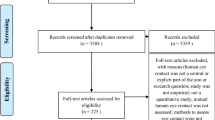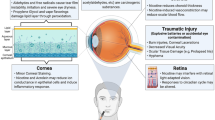Abstract
Objectives
This study aimed to evaluate students’ subjective symptoms associated with exposure to low levels of formaldehyde (FA) during a gross anatomy course and to survey how the risk of subjective symptoms was affected by exposure to FA.
Methods
We conducted three questionnaire surveys of 125 students enrolled in an anatomy course (FA exposure group) and 124 students not enrolled in the course (FA nonexposure group) before, during, and 6 months after the course. The questionnaire included questions inquiring about subjective symptoms, sex, age, and allergies. We analyzed differences in the prevalence of subjective symptoms in distinct survey periods. Furthermore, we analyzed the relationship between the subjective symptoms and exposure to FA after adjusting for allergy, sex, and age using multiple logistic regression analysis.
Results
The prevalence of some of the ocular, nasal, and nonspecific symptoms in the FA exposure group was low before the course, increased during the course and decreased 6 months after the course. A significant positive relationship was observed between exposure to FA and some symptoms after adjusting for allergy, sex, and age.
Conclusions
We identified some concrete symptoms associated with exposure to FA. We suggest that the exposure to low levels of FA influences students’ subjective symptoms.


Similar content being viewed by others
References
Wantke F, Focke M, Hemmer W, Bracun R, Wolf-Abdolvahab S, Gotz M, et al. Exposure to formaldehyde and phenol during an anatomy dissecting course: sensitizing potency of formaldehyde in medical students. Allergy. 2000;55:84–7.
Lu Z, Li CM, Qiao Y, Yan Y, Yang X. Effect of inhaled formaldehyde on learning and memory of mice. Indoor Air. 2008;18:77–83.
Matsuoka T, Takaki A, Ohtaki H, Shioda S. Early changes to oxidative stress levels following exposure to formaldehyde in ICR mice. J Toxicol Sci. 2000;35:721–30.
Kunugita N, Nakashima T, Kikuta A, Kawamoto T, Arashidani K. Exposure to formaldehyde during an anatomy dissecting course. J UOEH. 2004;26:337–48. (in Japanese with English abstract)
Mizuki M, Tsuda T. Relationship between atopic factors and physical symptoms induced by gaseous formaldehyde exposure during an anatomy dissection course. Jpn J Allergol. 2001;50:21–8. (in Japanese with English abstract)
Ohmichi K, Matsuno Y, Komiyama M, Fukuda H, Todaka E, Ohta M, et al. Study of formaldehyde concentration during gross anatomy laboratory in Chiba University. Jpn J Clin Ecol. 2005;14:112–8. (in Japanese with English abstract)
Takayanagi M, Sakai M, Ishikawa Y, Murakami K, Kimura A, Kakuta S, et al. Formaldehyde concentrations in the breathing zone of medical students during gross anatomy laboratory in Toho University. Kaibogaku Zasshi. 2007;82:45–51. (in Japanese with English abstract)
Tanaka K, Nishiyama K, Yaginuma H, Sasaki A, Maeda T, Kaneko S, et al. Formaldehyde exposure levels and exposure control measures during and anatomy dissecting course. Kaibogaku Zasshi. 2003;2003(78):43–51. (in Japanese with English abstract)
Mori M, Hara K, Ishitake T, Saga T, Yamaki K. Research on indoor levels of formaldehyde and subjective symptoms in medical students during a gross anatomy dissection course. Jpn J Clin Ecol. 2008;17:13–20. (in Japanese with English abstract)
Mori M, Hoshiko M, Hara K, Ishitake T, Saga T, Yamaki K. Reduction in indoor levels of formaldehyde in a gross anatomy dissection room by gradual intervention. Jpn J Clin Ecol. 2011;20:123–30. (in Japanese with English abstract)
Mori M, Hoshiko M, Hara K, Ishitake T, Saga T, Yamaki K. Effect of large-scale repair work on indoor formaldehyde levels and subjective symptoms in medical students during a gross anatomy dissection course. Jpn J Hyg. 2012;67:501–7. (in Japanese with English abstract)
Mori M, Hoshiko M, Hara K, Saga T, Yamaki K, Ishitake T. Changes in subjective symptoms and allergy state among medical students exposed to low-level formaldehyde 6 months after completion of a gross anatomy dissection course. Environ Health Prev Med. 2013;18:386–93.
Japanese Society of Occupational Health (JSOH). Recommendation of occupational exposure limits (2015–2016) The Japan Society for Occupational Health, Tokyo. J Occup Health. 2015;57:394–417.
Mori M, Hara K, Miyakita T, Ishitake T. Improvement in indoor air quality and physical health of users in a newly built school building in a university. Jpn J Hyg. 2011;66:122–8. (in Japanese with English abstract)
Hojo S, Ishikawa S, Kumano H, Miyata M, Matsui T, Sakabe K. Subjective and objective characteristics of patients with multiple chemical sensitivity in Japan. Jpn J Clin Ecol. 2007;16:104–16. (in Japanese with English abstract)
Takigawa T. Indoor air pollution by chemical substances and sick house syndrome. JJOMT. 2006;54:193–9. (in Japanese with English abstract)
Iwasawa S, Tsuda Y, Uchiyama T, Maruyama Y, Kanda H, Miyauchi H, et al. Effectiveness of wearing protective devices (gas masks and eye protectors) against exposure to formaldehyde during an anatomy lab course. J Sci Labour. 2009;85:120–31. (in Japanese with English abstract)
Acknowledgments
The authors thank the university medical students at Kurume University’s School of Medicine who participated in this study.
Author information
Authors and Affiliations
Corresponding author
Ethics declarations
Conflict of interest
The authors declare that they have no conflict of interest.
Rights and permissions
About this article
Cite this article
Mori, M., Matsumoto, Y., Kushino, N. et al. Comparison of subjective symptoms associated with exposure to low levels of formaldehyde between students enrolled and not enrolled in a gross anatomy course. Environ Health Prev Med 21, 34–41 (2016). https://doi.org/10.1007/s12199-015-0497-8
Received:
Accepted:
Published:
Issue Date:
DOI: https://doi.org/10.1007/s12199-015-0497-8




